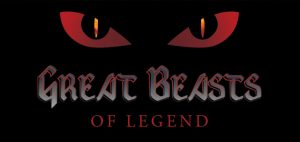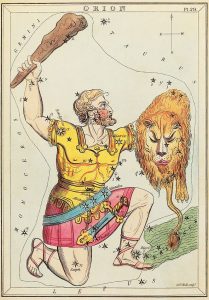Last Wednesday night (5th April) I attended a lecture at the University of Pennsylvania Museum of Archeology and Anthropology entitled ‘Beasts of the Night Sky’ given by Professor Patrick Glauthier of the University’s Department of Classical Studies. The lecture dealt with the myths and stories behind the familiar constellations the ancients used to understand the night sky. Wednesday’s lecture was the fifth in the museum’s series ‘Great Beasts of Legend’

Professor Glauthier began the lecture with a short description of how the night sky works. That is, how the constellations we see each night change with the seasons. How most constellations rise in the east and set in the west just as the Sun does but how the constellations near the pole star never set and how the planets move against the background of fixed stars, the Greek word planet means wanderer after all. Now it’s important to remember that to the ancients Earth was not a planet but the Sun and Moon were.
The Professor also described how in the ancient world the sky was the only way for people to keep track of time and the passing of the seasons. When Orion the Hunter was in the western sky just after the Sun set it was time to plant but when he rose in the east after sunset it was time to prepare for harvest.

This part of the lecture was all very familiar to me but there was a lot of good stuff to come. Professor Glauthier concentrated on the stories the Greeks and Romans told about the constellations so of course he began with Homer. Actually it turns out that Homer didn’t say much about the constellations, in fact he never mentions the constellations of the Zodiac at all.
In book 18 of the Iliad Homer mentions the Great Bear as facing Orion the hunter even though today we recognize several other constellations, most notably Gemini, as being between them. This indicates that Homer did not know about the constellation of Gemini! In fact according to Profession Glauthier the 12 constellations of the Zodiac were absorbed by the Greeks from Mesopotamia around the fifth century BCE.
Professor Glauthier also spoke about the group of constellations associated with the Myth of Perseus, Andromeda, the Sea Monster Cetus along with Andromeda’s parents Cepheus and Cassiopeia. The grouping of these constellations indicates that they are also very old, before the Greeks knew about the Zodiac. These were some of the first attempts to impose order on the night sky.
Now comes what I thought was the interesting part of the lecture because a couple of the Mesopotamian constellations the Greeks imported, Cancer the Crab and the Goat Fish of Capricorn for example had no Greek myth that could be applied to them so later Greek and Roman writers made up myths to try and explain how they got into the night sky. What was happening was that mythology was being manipulated in order to fit the growing knowledge of astronomy.
Professor Glauthier finished up the lecture with a brief description of how astrology began as a part of astronomy but how in the Roman period the attempts to foretell the future overshadowed the practical uses of the constellations in keeping track of the seasons.
Lectures like ‘Beasts of the Night Sky’ are regularly given at science and other museums throughout the world but very few people are aware of them. I’m a member of the U of P museum and if you live around Philadelphia or are planning a visit I heartily recommend stopping by. But wherever you live there are museums nearby so go to them, learn something, expand your brain. You may find you really enjoy it!
